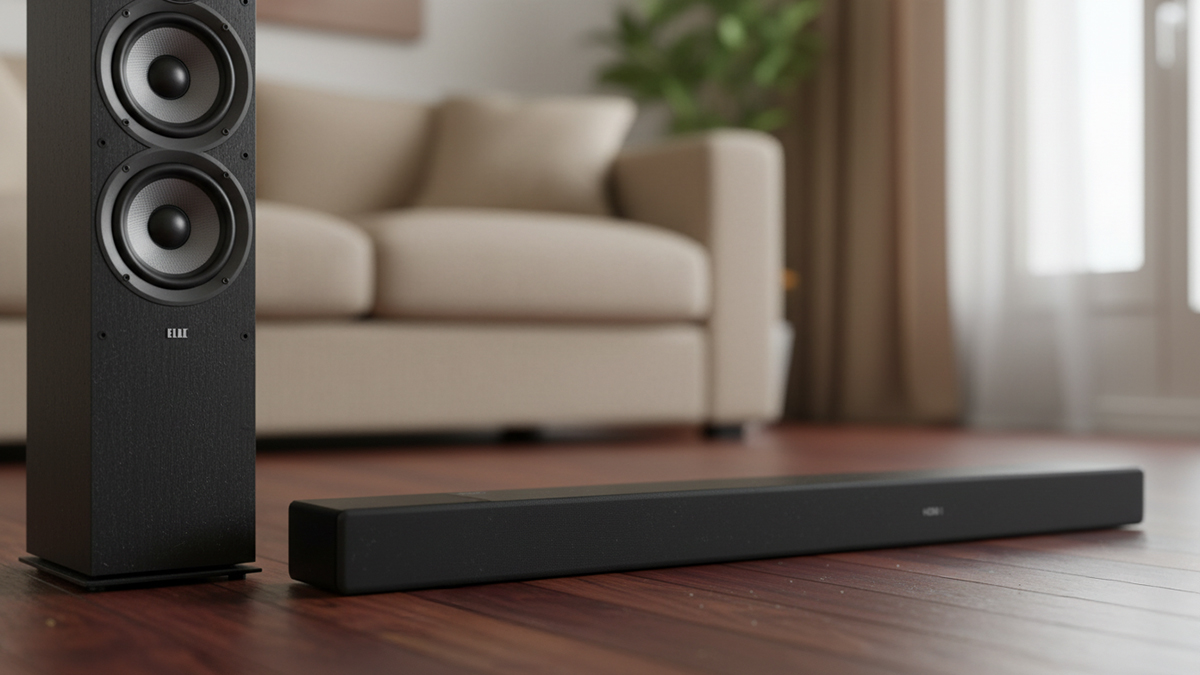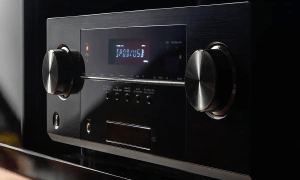Why This Choice Matters
You want better sound, not a living room full of arguments. A pair of tall speakers promises real stereo and concert like presence. A single bar under the TV offers cleaner dialogue and tidy cables. Both paths can be excellent. The best choice depends on your room, your habits, and your appetite for setup. Let’s sort it out in plain language, then point to specific models that owners praise for daily use.
What Your Ears Actually Hear
Stereo separates create a wide soundstage because each speaker has its own cabinet and its own place in the room. Instruments and effects appear between them, sometimes even beyond them, with depth and height that feels three dimensional. Movies and music both benefit from that precision. A soundbar aims for width with clever driver arrays and processing, and many ship with wireless rears to add wraparound. Bars can sound big, sometimes shockingly so, yet they still start from a single front location. When you sit close and centered, the gap narrows. Sit farther back, or off center, and well placed speakers usually keep the image together more convincingly.
Room Size And Seating Come First
Small apartments and bedrooms reward simplicity. A good bar with a compact sub cleans up dialogue and adds weight without dominating the space. Medium rooms can go either way. If you sit 8 to 12 feet from the screen and have room to place speakers on stands, floorstanding or bookshelf pairs pay off with richer stereo. Large open plans tend to favor real speakers or a flagship bar with rears included. A second row of seats also pushes you toward separates, because multiple listeners hear more consistent sound with spaced speakers.
Power, Headroom, And Why Volume Is Not The Point
Floorstanding speakers move more air with less strain. Even at moderate levels, they sound fuller and more relaxed, especially in the bass and lower midrange. That ease is headroom. A soundbar can get loud, yet many rely on a small sub to supply depth. In big rooms that sub works hard and can sound one note if pushed. The best bars fight this with better drivers, smarter bass management, and stronger subs, though physics still favors larger cabinets on stands or on the floor.
Ease Of Setup And Daily Use
This one is easy. A soundbar wins for convenience. One cable to the TV with ARC or eARC and you are watching. Wireless rears and subs pair with a button press. The TV remote usually runs volume. Floorstanding speakers need an amplifier or an AV receiver, speaker wire, and a bit of thought about placement. None of that is difficult, but it is more hands on. On the flip side, once speakers are dialed in, you are set for years and upgrades are simple. Add a better amp later, or a sub, and the system grows with you.
Upgradability And Long Term Value
Speakers age slowly. A solid pair of floorstanders can last a decade or more and still feel current. Receivers come and go, but the speakers stay. Soundbars evolve faster, because HDMI standards, streaming features, and app platforms keep moving. If you want to buy once and build slowly, speakers are the safer long game. If you would rather have a compact package you can replace every few years, a bar fits that plan.
Content Style, What You Watch And How You Listen
Dialogue driven shows and casual streams shine on a good bar, especially with a voice enhancement toggle and night mode. Big movies with layered soundtracks are still more convincing on real speakers, even in a simple 2.0 or 2.1 setup, because the front stage feels anchored and spacious. Music is the real separator. Stereo albums and live recordings usually sound more natural through floorstanders or a good pair of bookshelves. Bars can be fun for playlists and background listening, though they tend to flatten depth compared with spaced speakers.
Placement, The Honest Constraints
Floorstanding Speakers
They want a little breathing room. A foot or two off the back wall helps bass stay tight, and a slight toe in toward the listening position keeps imaging focused.
Soundbars And Subs
Soundbars are forgiving. Center the bar under the screen, push it to the front edge of the shelf so the drivers are not blocked, and you are most of the way there. Wireless subs often work best near the front wall midpoint or a spot a foot or two off a corner. If neighbors are close, isolation feet help keep bass from buzzing through the floor.
What Owners Keep Praising Right Now
Floorstanding Speakers
Klipsch RP 8000F II
Listeners love the lively presentation, strong dynamics at normal volumes, and easy placement. These towers deliver big theater energy in medium and large rooms without a massive amplifier. They also pair well with modest receivers, which helps the budget.
Polk Audio Signature Elite ES60
Owners highlight comfortable tone and clear dialogue when used for TV and movies. The footprint is friendly to living rooms, and the finish looks at home beside modern furniture. These feel like a safe, balanced choice for mixed use.
ELAC Debut 2.0 F6.2
A value favorite for people who want honest mids and smooth treble. Reviews often point to natural vocals and a forgiving top end that lets you listen for hours. Add a small sub later and you have a complete, affordable theater.
JBL Stage A190
Fans praise clean bass and a forward, energetic sound that works well with action movies and rock. If you want a punchy, fun presentation, this line gets it done without drama.
Soundbars
Samsung HW Q990D
A go to recommendation for full wraparound in one purchase. It ships with wireless rears and a capable sub, supports Dolby Atmos, and includes modern video passthrough so current game consoles and players stay happy. Owners like that it needs little fiddling once set.
Sony HT A7000
A modular flagship with a refined sound. Buy the bar first, then add a sub and wireless rears when you are ready. Users single out the wide soundstage for a single unit and the straightforward app. Gamers appreciate the clean passthrough path to the TV.
JBL Bar 700
Detachable battery powered surrounds solve the rear outlet problem for movie night. Owners enjoy the punchy sub, crisp dialogue, and the flexibility to stash the rears on the charger when not in use.
Sonos Arc
A favorite for clean looks and a polished app. Add the brand’s sub and compact rears later. People mention effortless daily use and steady reliability with TV apps, which is exactly what many living rooms need.
Real World Matchups You Can Copy
Small Apartment, One Sofa, Late Night Viewing
Pick a compact bar with a small sub. Sonos Arc or JBL Bar 700 gives you clear voices, easy control, and enough bass to feel satisfying at modest levels. Save a night preset with the sub trimmed slightly and dialogue boosted one notch.
Medium Living Room, 8 To 12 Feet Seating, Mixed Movies And Music
Choose floorstanders if you can place them. Klipsch RP 8000F II or Polk ES60 on either side of the TV with a slim receiver will make both films and albums come alive. Add a sealed 12 inch sub later for body without boom.
Large Room Or Open Plan, Watch Parties And Sports
Go straight to a flagship bar with rears included, or a serious speaker pair with a sub. Samsung HW Q990D is the easiest full surround route. If you want a cleaner stereo image for music, ELAC F6.2 with a capable sub gives you scale without complexity.
Cost, And What It Really Buys
A good bar often costs about the same as an entry speaker pair plus a modest receiver. Soundbars pack in convenience, processing, and wireless bits. Speakers put budget into cabinets and drivers that last. Neither is wrong. If daily ease is priority one, the bar wins. If you want a system that can change with you, speakers are the better investment.
Pros And Cons, Without The Sales Pitch
Floorstanding Speakers
Pros: real stereo imaging, deep headroom at modest volume, long service life, endless upgrade paths, excellent for music and cinematic front stages.
Cons: more boxes and wires, careful placement required, needs an amplifier or receiver, can dominate small rooms.
Soundbars
Pros: fast setup, one remote lifestyle, tidy footprint, useful dialogue modes, wireless rears available, easy to live with day to day.
Cons: less precise imaging, bass can feel one note if pushed hard, upgrade options are limited, platforms age faster than passive speakers.
A Simple Decision Tree
If you value music as much as movies, have room for stands or towers, and enjoy dialing things in once, choose floorstanding speakers. If you just want the TV to sound clear and cinematic with minimal effort, pick a well reviewed soundbar and place the sub smartly. Still unsure, try a modular bar like Sony HT A7000 that can grow with rears and a sub later. Or start with a modest speaker pair and a small receiver, then add a sub when budget allows. Either route can be the right one.
Bottom Line
Both paths can make your room feel bigger and more alive. Bars win for convenience and a clean look. Floorstanding speakers win for depth, realism, and long term value. Match the choice to your room size, your seating, and how you actually watch and listen. Place things carefully, keep levels sensible, and revisit settings after a week of real use. Do that, and whether you pick tall speakers or a smart bar, you will spend more time enjoying your system and less time thinking about it.



























